Delhi is a place of rich history and splendid architectural fervor which is to be seen to be believed. One cannot get enough of what Delhi has to offer, be it the street food or its nightlife.
Delhi exemplifies rich cultural and historical heritage in a way no other city can.
Listed below are 6 of the monuments which are home to New Delhi.
Explore top 10 Magnificent Monuments of Delhi 2025
1. India Gate
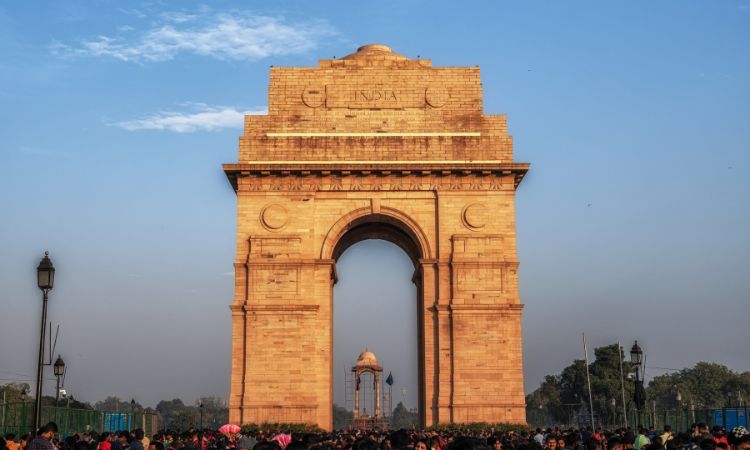
This people’s choice monument is the go-to place for every Delhihite. Designed by a British Architect Edwin Lutyens, India Gate, standing at 42 meters tall, is a war memorial.
It is a symbol of our soldiers’ sacrifice and patriotism.It contains the names of more than 13,000 soldiers on its walls made of red Bharatpur stone.
It is one such monument which represents Delhi on the travel and tourism map and is shown as the defacto symbol of Delhi frequently in Bollywood movies.
Under the India Gate Amar Jawan Jyoti – the eternal flame or the flame of the immortal soldier keeps burning to honor the soldiers who had sacrificed their lives during the India-Pakistan War of 1971.
2. Lotus Temple
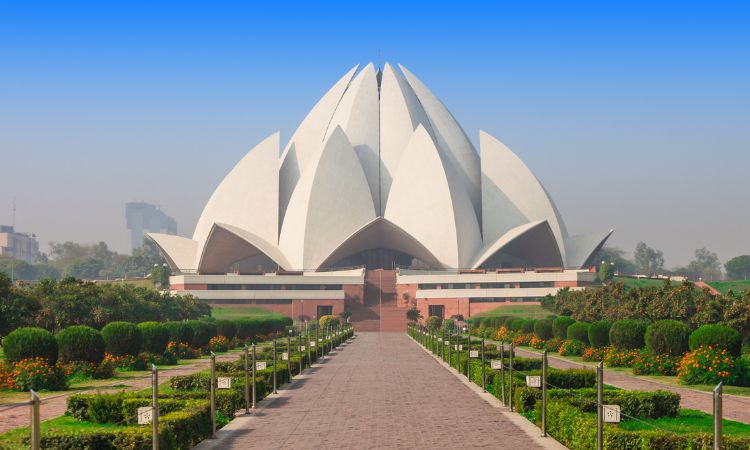
The Lotus Temple will enchant you with its boundless openness and architectural beauty. It is a Baha’I house of worship.
As the name suggests, is in the shape of a Lotus flower.
Currently, there are nine places of worship, out of which one (Lotus Temple) is in India. It has won numerous awards for its splendid architectural beauty.
The 27 petal-like designs with three in a cluster form the nine doorways opening into a central hall which is 40 meters tall.
Constructed on 26 acres of land and made of pristine white marble, the temple enjoys an abundance of visitors from all over the world every day.
3. Qutub Minar
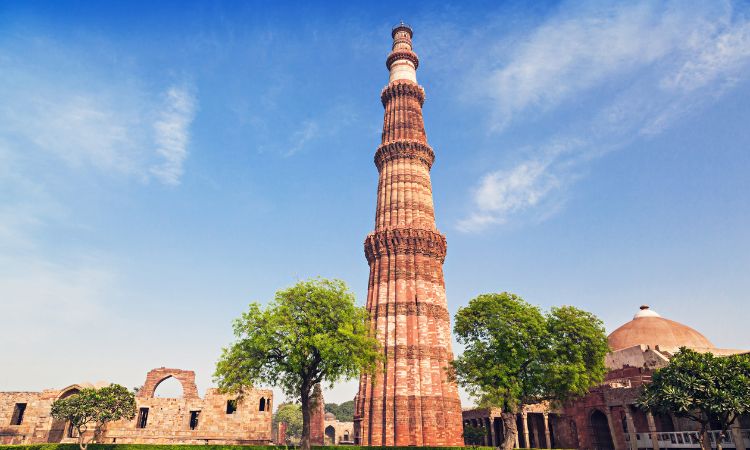
Qutub Minar is a tall minaret based on Iranian architecture that forms part of the Qutub complex, a UNESCO World Heritage Site.
It is a towering 73meters tall tower consisting of five stories. It tapers from 14.3m at the base to 2.7m at the very top.
The tower contains a spiral staircase of total 379 steps.
The lower three stories are made of red sandstone while the fourth is made of marble and the fifth and last one of marble and sandstone. There is calligraphy as well as decorative motifs on the upper levels.
It is surrounded by the famous Iron Pillar of Delhi, which is known to have impeccable anti-rust properties.
4. Chhatarpur Temple
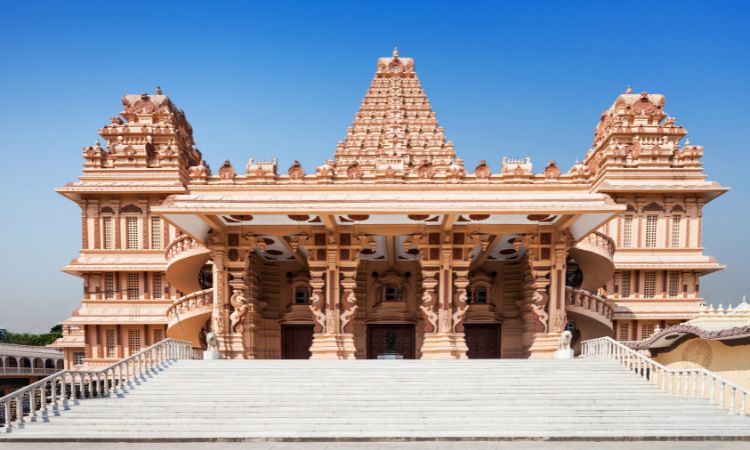
Located in the South of Delhi, just 4 km from Qutub Minar, the Chhatarpur Temple is dedicated to the Goddess Katyayani.
If one is considering visiting a grand temple, then this temple would fit the bill. The temple complex is spread over 60 acres.
Offering prayers here is an experience in itself as this shrine opens in a large prayer hall, where religious discourses are held.
An old tree stands at the entrance of the main temple where devotees tie holy threads for wish fulfillment.
Another shrine of Goddess Durga is open to devotees morning to evening. The temple has been built in both South and North Indian style of temple architecture.
5. Red Fort
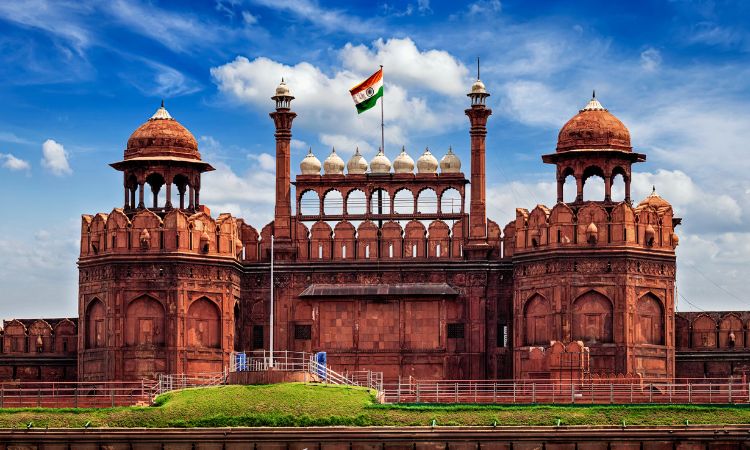
Located in the center of Delhi and built in 1639 by the Mughal Emperor Shah Jahan, the Red Fort is famous for its red sandstone construction.
It served as the main residence of the emperors of the Mughal Dynasty for nearly 200 years. It is a UNESCO World Heritage Site.
It has an area of 254.67 acres, making it the largest monument in Delhi. It is enclosed by 2.41 kilometers of defensive walls.
The fort is octagonal in shape. The beautiful marble, floral decorations and double domes in the fort’s buildings exemplify the Mughal architecture.
Every year on the 15th August, the Prime Minister hoists the Indian flag at the main gate of the fort and delivers a nationally-broadcast speech.
6. Akshardham Mandir
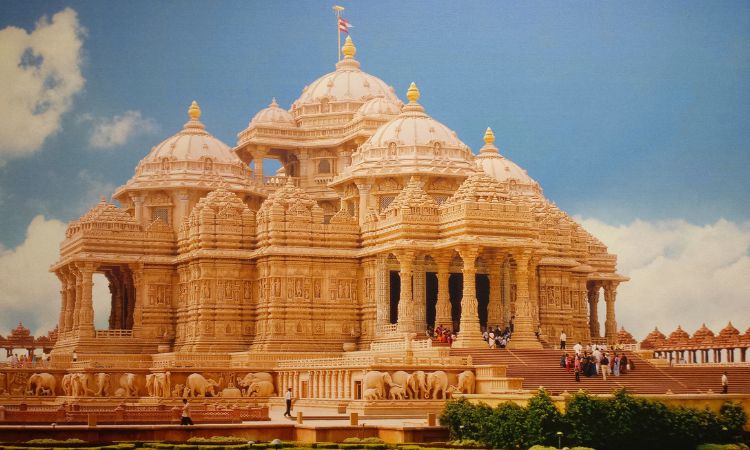
The temple, which attracts approximately 70 percent of all the tourists who visit Delhi.
There are many other monuments which will enchant your eyes with their architectural beauty but there is one which remains the star of the show.
If there is one temple which defines beauty, grandeur, and holiness all at once, it is the Swaminarayan Akshardham Complex, also called Akshardham.
It showcases the essence of India’s ancient art, traditions, and wisdom. It is a famed, global tourist spot which holds the World Record for being the world’s largest comprehensive Hindu Temple.
The main attraction is the Akshardham Mandir at the center of the complex, which was built according to Vastu Shastra.
Featuring a blend of architectural styles, it is entirely constructed from Rajasthani pink sandstone and Italian Carrara marble and has intricate carvings of dancers, musicians, and deities.
It is not only a spiritual center but also a cultural one, as it contains 3 beautiful exhibitions for the public, namely –
- SahajanandDarshan (hall of values),
- NilkanthDarshan (theatre) and
- SanskrutiVihar (cultural boat ride).
Apart from these, there is a musical fountain show which is played to an audience and also a thematic garden.
In order to have maximum lifespan the grand, ancient-style temple makes no use of Ferrous metal, in line with traditional Hindu architectural guidelines.
Thus it has no structural support from steel or concrete making it all the more appealing from an architectural point of view.
Mere reading doesn’t do justice to the beauty of these monuments, one must take out time and visit them to experience their true grandeur.
7. Rashtrapati Bhavan
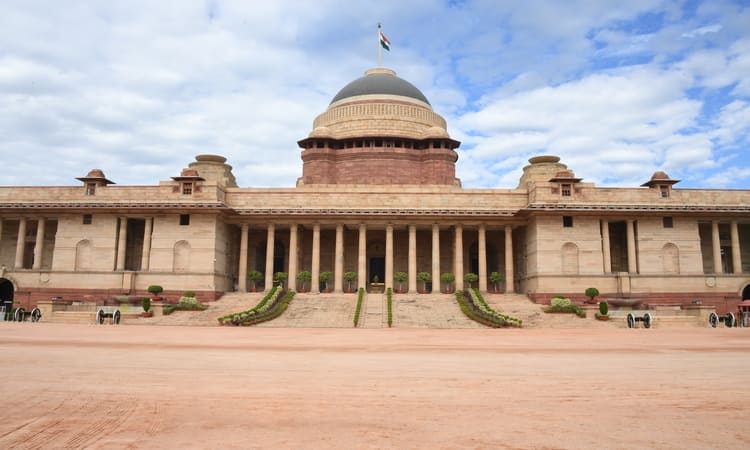
Rashtrapati Bhavan is the official residence of the President of India. It is a stunning blend of Western classical and Indian architecture which was designed by Sir Edwin Lutyens and was completed in 1929.
Spread over 33 acres, it features 340 rooms, including presidential suites, offices, and ceremonial halls. The design incorporates Indian elements like chhatris, jaalis, and intricate carvings inspired by Hindu, Jain, and Buddhist traditions. Originally built as the Viceroy’s House during British rule, it was repurposed post-independence to symbolize India’s sovereignty and democratic ethos.
The Rashtrapati Bhavan Museum and Mughal Garden are key attractions, offering a glimpse into history, governance, and exquisite landscaping. Guided tours provide visitors insights into its historical and cultural significance. It remains a prominent venue for state functions, official ceremonies, and cultural events, reflecting India’s rich heritage and unity.
8. Jantar Mantar
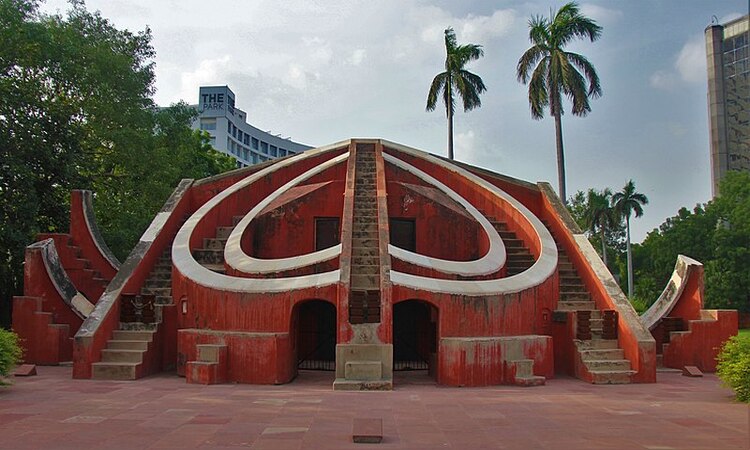
Jantar Mantar is located in the heart of Delhi. It is an astronomical observatory built by Maharaja Jai Singh II of Jaipur in 1724. This UNESCO World Heritage Site houses 13 architectural instruments, designed to measure time, track celestial bodies, and predict astronomical events with remarkable accuracy.
The structure reflects a unique blend of science and architecture, with instruments like the Samrat Yantra, a giant sundial, and the Mishra Yantra, used to determine the shortest and longest days of the year. The observatory was constructed to refine astronomical calculations and improve calendar-making during the 18th century.
Its massive geometric shapes and precise alignments highlight the advanced knowledge of astronomy in ancient India. Jantar Mantar continues to attract visitors for its historical, scientific, and architectural significance, offering guided tours to explore its unique design and purpose. It stands as a testament to India’s rich scientific heritage and the innovative spirit of its time.
9. Birla Mandir Temple ( Lakshmi Narayan)
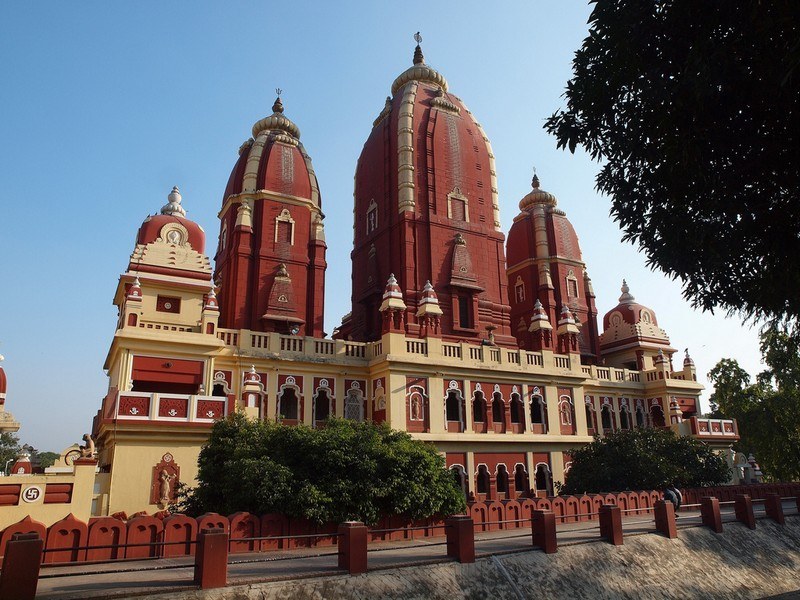
Birla Mandir, also known as the Laxmi Narayan Mandir, is a famous Hindu temple located in the heart of Delhi near Connaught Place. Built in 1939 by the Birla family, it is dedicated to Lord Vishnu (Narayan) and Goddess Laxmi, the deity of wealth and prosperity. The temple is renowned for its stunning architecture, peaceful ambiance, and cultural significance.
Key Highlights of Birla Mandir:
- Architecture: Constructed in the Nagara style, the temple is adorned with intricate carvings and murals depicting scenes from Hindu mythology.
- Cultural Significance: The temple is a symbol of India’s religious unity and welcomes people of all castes and religions, which was a progressive step at the time of its inauguration.
- Main Shrine and Sub-Shrines: The temple complex includes a main shrine dedicated to Laxmi and Narayan, surrounded by smaller shrines devoted to other deities like Lord Shiva, Lord Ganesha, and Lord Hanuman.
- Garden and Water Features: The temple premises are beautifully landscaped with lush gardens, fountains, and water features, providing a tranquil setting for devotees.
10. Humanyu Tomb
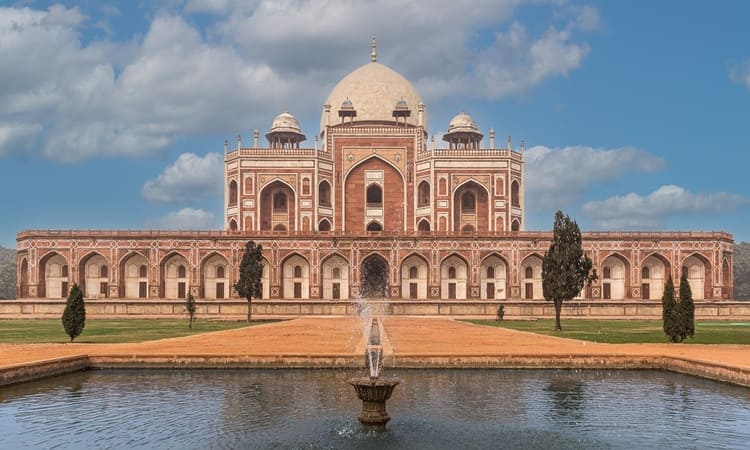
Humayun’s Tomb is a UNESCO World Heritage Site and one of Delhi’s most iconic monuments. Built in 1570 by Emperor Humayun’s widow, Empress Bega Begum, this tomb is a masterpiece of Mughal architecture and a precursor to the Taj Mahal. Located in Nizamuddin East, it is surrounded by lush gardens and holds immense historical and architectural significance.
- Designed by Persian architect Mirak Mirza Ghiyas, the tomb is a stunning blend of Persian, Turkish, and Indian architectural styles, made primarily of red sandstone and marble.
- The tomb is set within a Charbagh (four-part) Persian-style garden with water channels symbolizing paradise, offering a serene atmosphere.
- This was the first garden-tomb in the Indian subcontinent and set the precedent for future Mughal monuments like the Taj Mahal.
- The tomb complex houses the graves of Emperor Humayun, his wives, and other Mughal royals.
- It underwent significant restoration work under the Aga Khan Trust for Culture to preserve its original grandeur.
